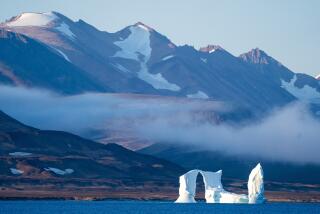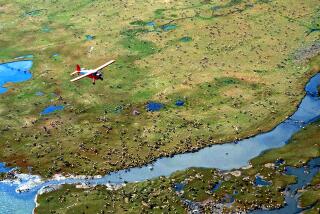Arctic Wildlife Refuge Termed Vulnerable to Drilling : Environment: New Administration study says oil exploration would seriously harm fragile ecosystem.
WASHINGTON — A new study by the Clinton Administration concludes that drilling for oil in the Arctic National Wildlife Refuge in northern Alaska would do significantly more damage to the region’s fragile ecology and wilderness character than previously thought.
Both the Senate and the House of Representatives passed measures in favor of allowing oil drilling in the refuge as part of their budget resolutions.
“The irreplaceable and enduring value of the Arctic Refuge to the nation as a world-class natural area and wilderness is far greater than the short-term economic gain to be garnered from industrial development,” concludes a draft of the study prepared by the Department of Interior. The report has not been released, but a copy was obtained by The Washington Post.
The report, prepared by the Fish and Wildlife Service at the request of the Alaska office of the Interior Department, examines new scientific information compiled since a comprehensive environmental review was conducted in 1987 during the George Bush Administration. That document played down the environmental consequences and recommended a drilling program to harvest the estimated 3.2 billion gallons of oil then thought to be recoverable from the refuge’s coastal plain on the Beaufort Sea.
The new study was commissioned strictly to examine the potential environmental effects of oil drilling, not its possible local or national economic benefits. But, in a separate report last June, the U.S. Geological Survey reduced its estimate of the maximum potential oil yield from the coastal plain by more than 50%.
Calling the refuge “the outstanding example of remaining American wilderness,” the new study said petroleum drilling would have greater adverse impacts than earlier believed on the huge Porcupine caribou herd, which migrates through the area; on physical resources, such as scarce water supplies; and on the fragile vegetation of the tundra.
“The refuge is the only conservation area in the nation that provides a complete range of Arctic ecosystems, functioning in balance to perpetuate wildlife populations,” the analysis says.
The new report by the Interior Department is likely to bolster the Administration’s view that drilling should continue to be banned in the 19-million-acre refuge, which is home to one of the continent’s largest caribou herds, musk oxen, brown bears, polar bears and many species of birds and marine mammals.
In congressional testimony last month, Interior Department officials told a Senate panel that Secretary Bruce Babbitt would recommend that President Clinton veto any budget legislation that includes drilling in the 1.5-million-acre coastal plain of the Arctic refuge. Calling the coastal plain “an irreplaceable piece of our national heritage,” Babbitt has predicted that oil exploration and development there would disrupt the “ancient pageant of wildlife moving through the seasons of an enchanted landscape.”
The new, gloomier analysis of the potential environmental consequences of drilling in the refuge seems unlikely to deter Congress. The House and Senate committees charged with turning the oil-drilling recommendations passed by both houses into actual legislation are headed by Alaska Republicans, Sen. Frank H. Murkowski and Rep. Don Young, who are firmly committed to drilling. And the senior Democrat on the Senate Energy and Natural Resources Committee, Sen. J. Bennett Johnston (D-La.), has predicted that proponents of drilling in the refuge have enough votes to prevail.
Nonetheless, the new Interior Department analysis will add fuel to an emotional argument that has persisted for 15 years, ever since Congress left the question of oil drilling in the refuge unresolved when it passed the 1980 Alaska National Interest Lands Conservation Act.
Conservationists adamantly oppose oil drilling in the refuge.
More to Read
Sign up for Essential California
The most important California stories and recommendations in your inbox every morning.
You may occasionally receive promotional content from the Los Angeles Times.










